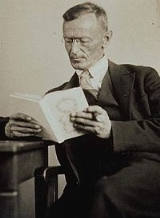
. His best-known works include Steppenwolf
, Siddhartha
, and The Glass Bead Game
(also known as Magister Ludi), each of which explores an individual's search for authenticity, self-knowledge and spirituality.
Hermann Hesse was born on 2 July 1877 in the Black Forest
town of Calw
in Württemberg
, Germany
.
In the beginning was the myth. God, in his search for self-expression, invested the souls of Hindus, Greeks, and Germans with poetic shapes and continues to invest each child's soul with poetry every day.![]()
Oh, love isn't there to make us happy. I believe it exists to show us how much we can endure.
![]()
That's the way it is when you love. It makes you suffer, and I have suffered much in the years since. But it matters little that you suffer, so long as you feel alive with a sense of the close bond that connects all living things, so long as love does not die!
:As translated by Hilda Rosner
![]()
I was given the freedom to discover my own inclination and talents, to fashion my inmost pleasures and sorrows myself and to regard the future not as an alien higher power but as the hope and product of my own strength.
![]()
That is where my dearest and brightest dreams have ranged — to hear for the duration of a heartbeat the universe and the totality of life in its mysterious, innate harmony.
![]()
Was that really love? I saw all these passionate people reel about and drift haphazardly as if driven by a storm, the man filled with desire today, satiated on the morrow, loving fiercely and discarding brutally, sure of no affection and happy in no love...
![]()
Young people have many pleasures and many sorrows, because they only have themselves to think of, so every wish and every notion assume importance; every pleasure is tasted to the full, but also every sorrow, and many who find that their wishes cannot be fulfilled, immediately put an end to their lives.
![]()

